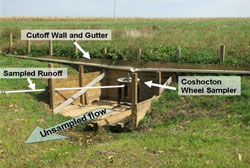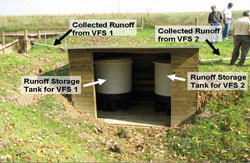Manure Plot Research Design
National Agriculture Information
- Agriculture
- Basic Information
- Where You Live
- Frequent Questions
- Sectors
- A to Z Subject Index
- Air
- Business Assistance
- Health & Safety
- Pesticides
- Site & Equipment
- Sustainability
- Water
- Laws & Regulations
- Resources


Cutoff walls, Coshocton Wheel samplers (top photo), and runoff storage tanks for manure plots at the NAEW (bottom photo). (Photos courtesy USDA/ARS)
The objective is to compare environmental impacts of surface-applied manure in winter (frozen ground) vs spring application.
Six plots: 300 ft or 400 ft x 40 ft
Location: USDA-ARS, North Appalachian Experimental Watershed (NAEW), Coshocton, Ohio.
- 3 plots with a 200 ft filter bed
- 3 plots with a 100 ft filter bed
Four plots will receive manure on frozen ground at a rate of 10 tons per acre of a slurry-type from a beef feedlot:
- 2 with a 200 ft filter bed
- 2 with a 100 ft filter bed
Two control plots will receive no manure.
Manure will be applied on frozen ground during December to February.
Quality and quantity of runoff water will be measured.
Runoff samples will be analyzed for:
- Nutrients - NH4, NO3, & PO4(analysis by ARS)
- Chemical oxygen demand (COD) (analysis by ARS)
- Pathogens - E. coli &/or enterococci (analysis by USEPA)
Four small, continuous corn watersheds (< 2 acres) will receive winter application of manure, applied at the N rate for corn.
- 2 watersheds will receive liquid swine manure;
- 2 watersheds will receive turkey litter.
- manure will be applied with a 100 ft set back from the bottom of the watershed
- runoff samples will be analyzed for the same constituents as in the plot runoff samples.
This project is to be conducted in cooperation with US EPA (Office of Research and Development, Cincinnati, and Region 5, Chicago)
![[logo] US EPA](../gif/logo_epaseal.gif)